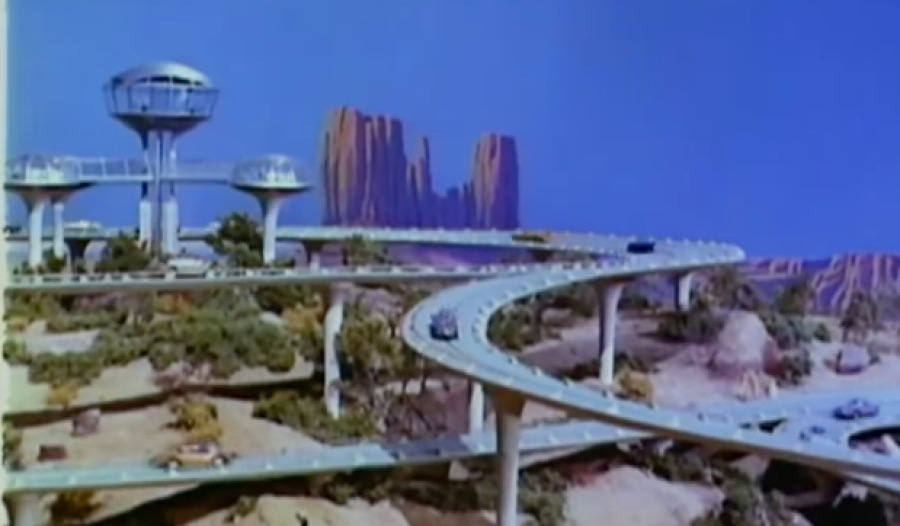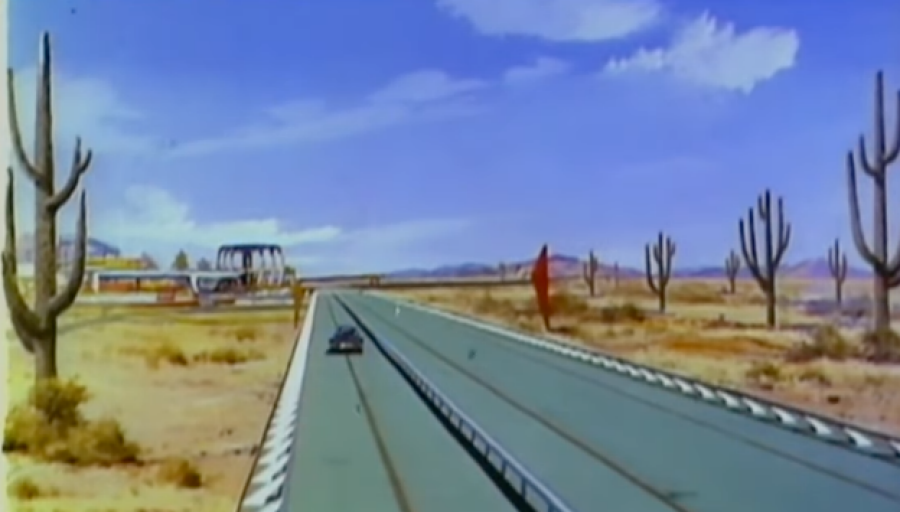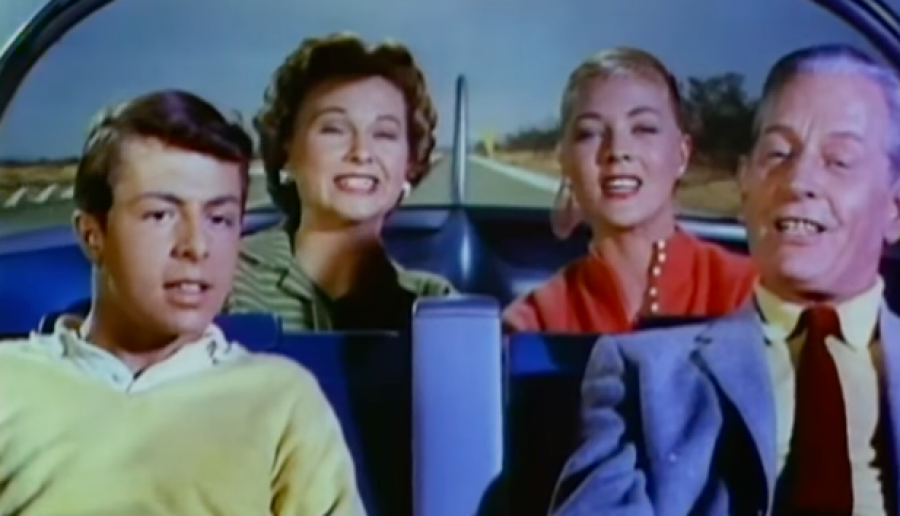By Eric J. Savitz, editor-in-chief, General Motors
General Motors is a big believer in the promise and power of hands-free driving. As of June 30, our Super Cruise hands-free driver assistance technology1 was installed on more than 500,000 vehicles, more than double the year-ago level. The technology is now offered on 23 models. And customers seem to like it: We expect 2025 revenue from Super Cruise of more than $200 million and project the number to more than double in 2026. And GM remains hard at work on developing personal autonomous vehicles.
You may not be aware that GM has been imagining the potential of autonomous driving for a long time - you can see vivid evidence of that in “Key to the Future,” a short 1956 film that is the second entry in our new GM Theater series highlighting interesting video in the GM archives.
A fabulous tomorrow
Coming in just under nine minutes long, “Key to the Future” is a kooky bit of musical sci-fi fluff. The film wasn’t intended to be watched alone - it was originally part of an extravagant 35-minute multimedia experience of the same name produced for the 1956 edition of Motorama, a traveling car expo General Motors held periodically from 1949 to 1961. The original production included a live cast of 70 singers, dancers, and musicians, performed six times a day. When it was announced in January 1956, GM described the experience as “a bubbling show that leaps from a tuneful today into a fabulous tomorrow.”
For regular GM News readers, Motorama might ring a bell – in the launch edition of GM Theater, we featured another 1956 short film tied to Motorama called “Design for Dreaming.” This was no common car show: across multiple stops in New York, Miami, Los Angeles, Boston, and other cities, more than 2 million people visited Motorama that year.
“Key to the Future” opens with a shot of an iconic nuclear family – Mom and Dad, and their son and daughter – sitting in a car (the girls in the back), singing a song about how annoying it can be to drive in bumper-to-bumper traffic.
“We’ve got a slowdown, slooowdown,” they riff. “So much traffic cuts the flooow down.” Then Dad croons a solo: “Till we bring the highways up to date, you can bet your high compression, we’re gonna be late.”
That song, and the rest of the music in the film, was written by Jack Brooks, a well-known songwriter of the era who among other things penned the Italian meatball “That’s Amore.” (You know that one: “When the moon hits your eye, like a big pizza pie….”)
Anyway, a few moments later, Junior, sitting in the passenger seat, turns on the radio (it’s AM only, with a Chevrolet bowtie in the middle of the dial) and wonders what they’d hear on the radio if only it were the far-off year of “nineteen hundred and seventy-six.”
And just like that, the family suddenly is whizzing down a remarkably empty Arizona desert highway in a Firebird II, a 1956 concept car with a turbine engine that looks ready to take off for the moon. (You can read more about the Firebird II in our recent Retro Rides feature on GM’s experiments with turbines.)
Junior pushes a button and says in careful staccato over a microphone: “Hello tower, this is Firebird II … How are things on the safety autoway?”
The film cuts to a dashing uniformed gentlemen with a big wide belt sitting in what looks like a futuristic aircraft control tower. “Tower to Firebird 2, all traffic moving in normal pattern.”
Who wants ice cream?
Soon, Junior asks for directions to Chicago. (Kind of a long trip; Phoenix to Chicago is about 1,800 miles.) A little later, Tower Dude gives the family permission to move to the electronic control strip in the center lane, at which point Dad takes his hands off the wheel, which in a bit of mechanical prestidigitation, recesses into the dash. Dad then decides to smoke a big stogie – that car must have had superior air circulation. The rest of the family, meanwhile, snacks on ice cream and orange juice found in a little compartment hidden in the dash.
After the clan spends a little time spinning around the country, Tower Dude eventually points them to a hotel where they can stop – the Sunset Inn - which prompts another song, this time from a flower-arranging hotel staffer.
She warbles that her lodgings offer “push button living at its very best,” along with “automatic sleep control in every bed,” and “predigested food cooked by infrared.”
Um, predigested food? Eww.
Sadly, the actors aren’t identified in the credits, so I can’t tell you their names. But the crew has an impressive pedigree. In particular, “Key to the Future” was directed by the choreographer Michael Kidd, who won five Tony Awards, along with an honorary Academy Award in 1997 recognizing his “services to the art of the dance,” in films like “Guys and Dolls” and “Seven Brides for Seven Brothers.”
While it wasn’t the most accurate depiction of the future, “Key to the Future” is a vivid demonstration that the thirst for hands-free driving is at least 70 years old. And it sure is a hoot to watch. (But skip the predigested popcorn.)
1Always pay attention while driving and when using Super Cruise. Do not use a hand-held device. Requires active Super Cruise plan or trial. Terms apply. Visit cadillacsupercruise.com, chevysupercruise.com, https://www.buick.com/explore/technology/super-cruise or gmc.com/connectivity-technology/super-cruise for compatible roads and full details.
For more stories about GM history, visit our Retro Rides page, and stop by the GM Heritage website.
Have a favorite GM film or vehicle you’d like us to feature? Drop us a line at news@gm.com.

General Motors is a big believer in the promise and power of hands-free driving. As of June 30, our Super Cruise hands-free driver assistance technology1 was installed on more than 500,000 vehicles, more than double the year-ago level. The technology is now offered on 23 models. And customers seem to like it: We expect 2025 revenue from Super Cruise of more than $200 million and project the number to more than double in 2026. And GM remains hard at work on developing personal autonomous vehicles.
You may not be aware that GM has been imagining the potential of autonomous driving for a long time - you can see vivid evidence of that in “Key to the Future,” a short 1956 film that is the second entry in our new GM Theater series highlighting interesting video in the GM archives.
A fabulous tomorrow
Coming in just under nine minutes long, “Key to the Future” is a kooky bit of musical sci-fi fluff. The film wasn’t intended to be watched alone - it was originally part of an extravagant 35-minute multimedia experience of the same name produced for the 1956 edition of Motorama, a traveling car expo General Motors held periodically from 1949 to 1961. The original production included a live cast of 70 singers, dancers, and musicians, performed six times a day. When it was announced in January 1956, GM described the experience as “a bubbling show that leaps from a tuneful today into a fabulous tomorrow.”
For regular GM News readers, Motorama might ring a bell – in the launch edition of GM Theater, we featured another 1956 short film tied to Motorama called “Design for Dreaming.” This was no common car show: across multiple stops in New York, Miami, Los Angeles, Boston, and other cities, more than 2 million people visited Motorama that year.

“Key to the Future” opens with a shot of an iconic nuclear family – Mom and Dad, and their son and daughter – sitting in a car (the girls in the back), singing a song about how annoying it can be to drive in bumper-to-bumper traffic.
“We’ve got a slowdown, slooowdown,” they riff. “So much traffic cuts the flooow down.” Then Dad croons a solo: “Till we bring the highways up to date, you can bet your high compression, we’re gonna be late.”

That song, and the rest of the music in the film, was written by Jack Brooks, a well-known songwriter of the era who among other things penned the Italian meatball “That’s Amore.” (You know that one: “When the moon hits your eye, like a big pizza pie….”)
Anyway, a few moments later, Junior, sitting in the passenger seat, turns on the radio (it’s AM only, with a Chevrolet bowtie in the middle of the dial) and wonders what they’d hear on the radio if only it were the far-off year of “nineteen hundred and seventy-six.”
And just like that, the family suddenly is whizzing down a remarkably empty Arizona desert highway in a Firebird II, a 1956 concept car with a turbine engine that looks ready to take off for the moon. (You can read more about the Firebird II in our recent Retro Rides feature on GM’s experiments with turbines.)
Junior pushes a button and says in careful staccato over a microphone: “Hello tower, this is Firebird II … How are things on the safety autoway?”
The film cuts to a dashing uniformed gentlemen with a big wide belt sitting in what looks like a futuristic aircraft control tower. “Tower to Firebird 2, all traffic moving in normal pattern.”
Who wants ice cream?
Soon, Junior asks for directions to Chicago. (Kind of a long trip; Phoenix to Chicago is about 1,800 miles.) A little later, Tower Dude gives the family permission to move to the electronic control strip in the center lane, at which point Dad takes his hands off the wheel, which in a bit of mechanical prestidigitation, recesses into the dash. Dad then decides to smoke a big stogie – that car must have had superior air circulation. The rest of the family, meanwhile, snacks on ice cream and orange juice found in a little compartment hidden in the dash.
After the clan spends a little time spinning around the country, Tower Dude eventually points them to a hotel where they can stop – the Sunset Inn - which prompts another song, this time from a flower-arranging hotel staffer.
She warbles that her lodgings offer “push button living at its very best,” along with “automatic sleep control in every bed,” and “predigested food cooked by infrared.”
Um, predigested food? Eww.
Sadly, the actors aren’t identified in the credits, so I can’t tell you their names. But the crew has an impressive pedigree. In particular, “Key to the Future” was directed by the choreographer Michael Kidd, who won five Tony Awards, along with an honorary Academy Award in 1997 recognizing his “services to the art of the dance,” in films like “Guys and Dolls” and “Seven Brides for Seven Brothers.”
While it wasn’t the most accurate depiction of the future, “Key to the Future” is a vivid demonstration that the thirst for hands-free driving is at least 70 years old. And it sure is a hoot to watch. (But skip the predigested popcorn.)
1Always pay attention while driving and when using Super Cruise. Do not use a hand-held device. Requires active Super Cruise plan or trial. Terms apply. Visit cadillacsupercruise.com, chevysupercruise.com, https://www.buick.com/explore/technology/super-cruise or gmc.com/connectivity-technology/super-cruise for compatible roads and full details.
For more stories about GM history, visit our Retro Rides page, and stop by the GM Heritage website.
Have a favorite GM film or vehicle you’d like us to feature? Drop us a line at news@gm.com.